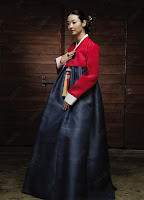A Norigae pendant is worn with a women's hanbok (Korean traditional clothing). It is tie to the outer goreum (a coat string) or the waist of a skirt. It gives a luxurious look to the entire outfit but also creates a subtle harmony between the radiant color of the hanbok jeogori (short jacket) and the dresses elegant folds. It was an accessory loved by all women of the Joseon dynasty from the royal family and yangban (ruling class) wives to the commoners.
Not only is the norigae used as an accessory alone, it contains the hopes and dreams of women. The various shapes and patterns, which includes animal inspired forms, usually contain some kind of meaning. The norigae is used as a good luck charm, hoping to bring something like eternal youth and wealth (or many sons). For example, the lotus flower and pomegranate stood for fertility and the turtle and peach represented longevity. A sword symbolized chastity while the incense pouch symbolized elegant feminine beauty. Along with these hopeful meanings, the norigae served as a wedding gift passed down from the parents or parents-in-law. It usually symbolized maternal love as it was traditionally passed down from mother to daughter.





















